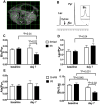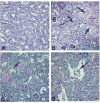Hyperpolarized 13 C magnetic resonance evaluation of renal ischemia reperfusion injury in a murine model
- PMID: 28708304
- PMCID: PMC5618802
- DOI: 10.1002/nbm.3765
Hyperpolarized 13 C magnetic resonance evaluation of renal ischemia reperfusion injury in a murine model
Abstract
Acute kidney injury (AKI) is a major risk factor for the development of chronic kidney disease (CKD). Persistent oxidative stress and mitochondrial dysfunction are implicated across diverse forms of AKI and in the transition to CKD. In this study, we applied hyperpolarized (HP) 13 C dehydroascorbate (DHA) and 13 C pyruvate magnetic resonance spectroscopy (MRS) to investigate the renal redox capacity and mitochondrial pyruvate dehydrogenase (PDH) activity, respectively, in a murine model of AKI at baseline and 7 days after unilateral ischemia reperfusion injury (IRI). Compared with the contralateral sham-operated kidneys, the kidneys subjected to IRI showed a significant decrease in the HP 13 C vitamin C/(vitamin C + DHA) ratio, consistent with a decrease in redox capacity. The kidneys subjected to IRI also showed a significant decrease in the HP 13 C bicarbonate/pyruvate ratio, consistent with impaired PDH activity. The IRI kidneys showed a significantly higher HP 13 C lactate/pyruvate ratio at day 7 compared with baseline, although the 13 C lactate/pyruvate ratio was not significantly different between the IRI and contralateral sham-operated kidneys at day 7. Arterial spin labeling magnetic resonance imaging (MRI) demonstrated significantly reduced perfusion in the IRI kidneys. Renal tissue analysis showed corresponding increased reactive oxygen species (ROS) and reduced PDH activity in the IRI kidneys. Our results show the feasibility of HP 13 C MRS for the non-invasive assessment of oxidative stress and mitochondrial PDH activity following renal IRI.
Keywords: Acute kidney injury; [1−13C]dehydroascorbic acid; [1−13C]pyruvate; hyperpolarization; magnetic resonance spectroscopy; mitochondrial dysfunction; oxidative stress.
Copyright © 2017 John Wiley & Sons, Ltd.
Figures





Similar articles
-
In situ lactate dehydrogenase activity: a novel renal cortical imaging biomarker of tubular injury?Am J Physiol Renal Physiol. 2017 Mar 1;312(3):F465-F473. doi: 10.1152/ajprenal.00561.2015. Epub 2016 Sep 21. Am J Physiol Renal Physiol. 2017. PMID: 27654895
-
Hyperpolarized 13C-MRS can Quantify Lactate Production and Oxidative PDH Flux in Murine Skeletal Muscle During Exercise.NMR Biomed. 2025 May;38(5):e70020. doi: 10.1002/nbm.70020. NMR Biomed. 2025. PMID: 40175064 Free PMC article.
-
The metabolic representation of ischemia in rat brain slices: A hyperpolarized 13 C magnetic resonance study.NMR Biomed. 2021 Jul;34(7):e4509. doi: 10.1002/nbm.4509. Epub 2021 Mar 28. NMR Biomed. 2021. PMID: 33774865
-
Rodent models of AKI-CKD transition.Am J Physiol Renal Physiol. 2018 Oct 1;315(4):F1098-F1106. doi: 10.1152/ajprenal.00199.2018. Epub 2018 Jun 27. Am J Physiol Renal Physiol. 2018. PMID: 29949392 Free PMC article. Review.
-
Improving the outcome of kidney transplantation by ameliorating renal ischemia reperfusion injury: lost in translation?J Transl Med. 2016 Jan 20;14:20. doi: 10.1186/s12967-016-0767-2. J Transl Med. 2016. PMID: 26791565 Free PMC article. Review.
Cited by
-
Imaging glutathione depletion in the rat brain using ascorbate-derived hyperpolarized MR and PET probes.Sci Rep. 2018 May 21;8(1):7928. doi: 10.1038/s41598-018-26296-6. Sci Rep. 2018. PMID: 29786697 Free PMC article.
-
Initial Experience of Metabolic Imaging with Hyperpolarized [1-13C]pyruvate MRI in Kidney Transplant Patients.ArXiv [Preprint]. 2024 Sep 10:arXiv:2409.06664v1. ArXiv. 2024. Update in: J Magn Reson Imaging. 2025 Apr;61(4):1969-1978. doi: 10.1002/jmri.29580. PMID: 39314508 Free PMC article. Updated. Preprint.
-
The Hippo pathway and its correlation with acute kidney injury.Zool Res. 2022 Sep 18;43(5):897-910. doi: 10.24272/j.issn.2095-8137.2022.110. Zool Res. 2022. PMID: 36052554 Free PMC article. Review.
-
Biomedical Applications of the Dynamic Nuclear Polarization and Parahydrogen Induced Polarization Techniques for Hyperpolarized 13C MR Imaging.Magn Reson Med Sci. 2021 Mar 1;20(1):1-17. doi: 10.2463/mrms.rev.2019-0094. Epub 2019 Dec 27. Magn Reson Med Sci. 2021. PMID: 31902907 Free PMC article. Review.
-
Multi-nuclear magnetic resonance spectroscopy: state of the art and future directions.Insights Imaging. 2022 Aug 17;13(1):135. doi: 10.1186/s13244-022-01262-z. Insights Imaging. 2022. PMID: 35976510 Free PMC article. Review.
References
-
- Hsu CY. Yes, AKI truly leads to CKD. Journal of the American Society of Nephrology : JASN. 2012;23(6):967–969. - PubMed
-
- Bucaloiu ID, Kirchner HL, Norfolk ER, Hartle JE, 2nd, Perkins RM. Increased risk of death and de novo chronic kidney disease following reversible acute kidney injury. Kidney international. 2012;81(5):477–485. - PubMed
-
- Hoerger TJ, Simpson SA, Yarnoff BO, Pavkov ME, Rios Burrows N, Saydah SH, Williams DE, Zhuo X. The future burden of CKD in the United States: a simulation model for the CDC CKD Initiative. American journal of kidney diseases : the official journal of the National Kidney Foundation. 2015;65(3):403–411. - PMC - PubMed
MeSH terms
Substances
Grants and funding
LinkOut - more resources
Full Text Sources
Other Literature Sources
Research Materials
Miscellaneous

